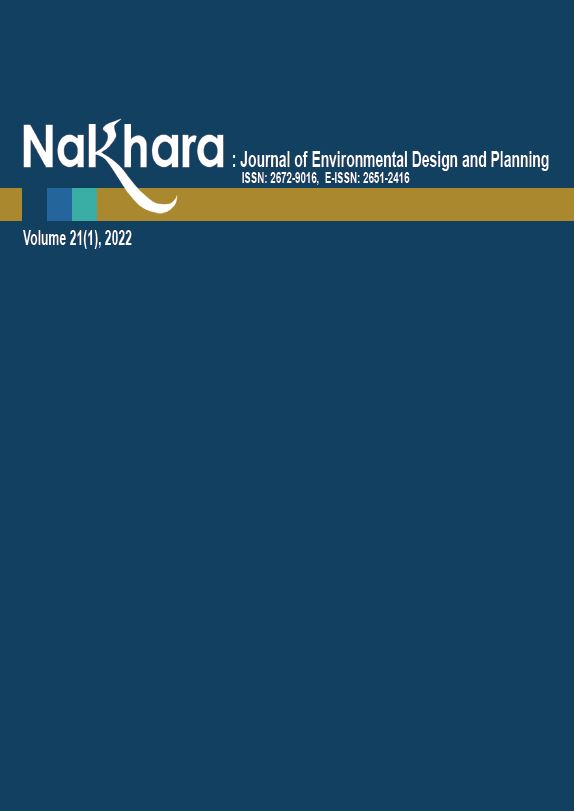Finding a Balance Between Public and Private Spaces in Student Housing Design in Thailand
Main Article Content
Abstract
Public and private spaces are of equal importance in promoting social interaction and ensuring self-contemplation for users of student housing. This research aims to establish the right balance among the public and private spaces as it is arguably one of the difficulties in housing design. A housing design is proposed for students of Chulalongkorn University in Bangkok, analyzed, and justified following the research findings to derive the desired balance between the public and private spaces. Several sets of literature of related work are undertaken as part of the qualitative design. At the same time, space syntax is used as a quantitative method to justify and finalize the findings. Accessibility, inclusiveness, visibility, and use of the space are the factors found responsible for identifying the degree of publicness of the spaces. Here the questioned balance could not be determined merely by using quantitative methodology. The reason lies with the inability of the spaces that could be called solely private or public, followed by the findings in a qualitative way. Henceforth, the balance exists through the in-between public and private spaces, which are also found to be responsible for creating a link and detachments between adjacent spaces. The factors and definitions found in the research can also be used to identify these in-between spaces. Furthermore, the scale used to study each space is also responsible for defining their publicness and, ultimately, the balance.
Article Details

This work is licensed under a Creative Commons Attribution-NonCommercial-NoDerivatives 4.0 International License.
References
Alitajer S. & Nojoumi G. M. (2016). Privacy at home: Analysis of behavioral patterns in the spatial configuration of traditional and modern houses in the city of Hamedan based on the notion of space syntax. Frontiers of Architectural Research, 5(3), 341-352. http://dx.doi.org/10.1016/j.foar.2016.02.003
Aureli V. P., Tattara, M. (2017). The room of one's own. Princeton.
Aravena, A. (2009). St Edward's University New Residence and Dining Hall. https://www.archdaily.com/31771/st-edwards-university-new-residence-and-dining-hall-alejandro-aravena
Awal, S. I. (2021). Definitions for public, private, and in-between spaces in student housing. Sarasatr, 4, 210-223.
Birch, E. L. (2007). Public and Private Space in Urban Areas: House, Neighborhood, and City. In R. A. Cnaan & C. Milofsky (Eds.), Handbook of Community Movements and Local Organizations (pp. 118-128). Springer US. https://doi.org/10.1007/978-0-387-32933-8_8
Brighenti, A. (2010). The publicness of public space: On the public domain. https://www.researchgate.net/publication/43116634_The_Publicness_of_Public_Space_On_the_Public_Domain
Carmona, M. (2010). Contemporary public space, part two: Classification. Journal of Urban Design, 15(2), 157-173.
Carr, S., Francis, M., Rivlin, L.G. & Stone, A. M. (1992). Public space. Cambridge University Press.
Danisworo. (1989). Konsep Peremajaan Kota. Institute Teknologi Bandung.
Evans, R. (2003). Translations from drawing to building and other essays. Architectural Association.
Ercan, M. A. (2010). Less public than before? In A. Madanipour (Ed.), Whose Public Space? Routledge.
Francis, M. (1989). 'Control as a dimension of public-space quality,'. In I. Altman and E. Zube (eds.), Public Places and Spaces. Plenum Press.
Gehl, J. (2002). Public space and public life city of Adelaide: 2002. Adelaide.
Gram-Hansen, R. (2012). Circular dormitories between city and private life: A comparative study of two iconic student halls in Copenhagen & Vienna. (unica euromaster in urban studies 4 cities graduate). [Master's Thesis, University of Copenhagen, Copenhagen].
Groak, S. (1992). The idea of building: Thought and action in the design and production of buildings. E&FN Spon.
Heilweil, M. (1973). The influence of dormitory architecture on resident behavior. Environment and Behavior, 5, 377-412.
Hertzberger, H. (1991). Lessons for students in architecture. 010 Publishers.
Hsia, V. W. (1968). Residence hall environment: A comparative study in architectural psychology. [Master's Thesis, University of Utah (Salt Lake City)].
Jackson, J. (1974). American public space. The Public Interest, 74(Winter), 52-65.
Kaplan, S. & Kaplan, R. (1982). Humanscape: Environment for people, university of Michigan. Ulrich's Book.
Karacor, E. K. (2016). Public vs. private: The evaluation of different space types in terms of publicness dimension. European Journal of Sustainable Development, 5, 51- 58. doi:10.14207/ejsd. 2016.v5n3p51.
Kenyon, E. L. (Ed.). (1999). A home from home: student's transitional experience of home. Routledge.
Kumar, S. I. A. (2012). Flexibility concept in design and construction for domestic transformation. Semantic Scholar.
Maccreanor, G. (1998). Adaptability. A+T Magazine, 12, pp. 40-45.
Madanipour, A. (2010). Whose public space? International case studies in urban design and development. Routledge.
Madden, D. J. (2010). Revisiting the end of public space: assembling the public in an urban park. City & Community, 9(2), 187-207.
Mehta, V. (2014). Evaluating public space. Journal of Urban Design, 19, 53-88. https://dx.doi.org/10.1080/13574809.2013.854698
Møller, C. F. (2016). Student housing. https://www.archdaily.com/785806/student-housing-cf-moller
Neufert, E. (1980). Architect's data (second (International) English Edition). Blackwell Science Ltd.
Salman, H. (1968). Medieval cities. Studio Vista.
Scalbert, I. (2004). A Right to difference: The architecture of Jean Renaudie. Architectural Association.
Schneider, T. & Till, J (2007). Flexible housing. Architectural Press.
Sommer, R. & Peterson, P. (1966). Study carrels re-examined. https://scholar.google.com/scholar?q=Sommer,+R.+%26+Peterson,+P.+(1966).+Study+Carrels+Re-examined.+(mimeo).&hl=en&as_sdt=0&as_vis=1&oi=scholart
Turner, A. (2001, May 7-11). A program to perform visibility graph analysis [Paper presentation]. The Third International Space Syntax Symposium, Atlanta, USA.
Vale, I. K. a. B. (2014, December 10-13). Shared Space in a Student Dorm [Paper presentation]. The Architectural Research through to Practice: 48th International Conference of the Architectural Science Association, University of Genoa, Italy.
van der Ryn, S. & Silverstein, M. (1967). Dorms at berkley: And environmental analysis. Educational Facilities Laboratories.
Whyte, W. H. (1985). The social life of small urban space. The Conservation.
Zahrah, A. D. N. a. W. (2011, June 15-17). Public Open Space Privatization and Quality of Life, Case Study Merdeka Square Medan [Paper presentation]. The ASEAN Conference on Environment-Behavior Studies, Savoy Homann Bidakara Bandung Hotel, Bandung, Indonesia.

